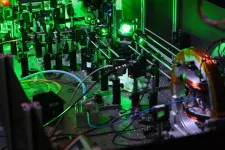A psychologist's guide to donating more effectively to charities
2021-04-29
(Press-News.org) The decision to donate to a charity is often driven by emotion rather than by calculated assessments based on how to make the biggest impact. In a review article published on April 29 in the journal Trends in Cognitive Sciences, researchers look at what they call "the psychology of (in)effective altruism" and how people can be encouraged to direct their charitable contributions in ways that allow them to get more bang for the buck--and help them to have a larger influence.
"In the past, most behavioral science research that's looked at charitable giving has focused on quantity and how people might be motivated to give more money to charity, or to give at all," says first author Lucius Caviola (@LuciusCaviola), a postdoctoral researcher in the Department of Psychology at Harvard University. "Our paper focuses on the effectiveness of giving--how people decide which charity to give to and ways that people can be motivated to give to charities that are more effective."
In the paper, the authors present a framework that distinguishes between motivation-based and knowledge-based influences on charitable giving. They note that although people often say they want to give effectively, they may be drawn to charities that are less effective and may not know how to determine which charities are more effective. The authors also discuss interventions that could encourage more effective altruism, such as providing more tangible details about a charity's intervention strategies and how donors' money is used.
Caviola believes that overhead ratios, which report what portion of donations goes to a charitable organization's costs of operation versus its cause, and which many people focus on, are not the best way to measure a charity's effectiveness. "These are completely different things, and I would argue that overhead ratio is irrelevant," he says. "When someone does research before buying a car, they want to get the best car for their money, not the one where the company devoted the highest percentage of its profits directly to manufacturing costs."
Instead, he says, more people should defer to experts that evaluate charities based on their effectiveness. "According to expert estimates, the most effective charities are often a hundred times more effective than typical charities," the authors write. "A $100 donation can save a person in the developing world from trachoma, a disease that causes blindness. By contrast, it costs $50,000 to train a guide dog to help a blind person in the developed world. This large difference in impact per dollar is not unusual." The authors cite the organization GiveWell as a reliable source of such information, based on its criteria designed to help donors do as much good as possible with every donation they make.
The authors acknowledge the importance of emotion in donating to charity and suggest that dividing donations between charities that are emotionally appealing and those that have the greatest impact can be an effective way to address both sides of this issue. "Research has shown that there are psychological conflicts between these two preferences," Caviola says. "We have demonstrated that if you allow people to split their contributions, it can help them to resolve these conflicts."
INFORMATION:
This work was supported by EA Funds and EA Grants.
Trends in Cognitive Sciences, Caviola et al.: "The Psychology of (In)Effective Altruism" https://www.cell.com/trends/cognitive-sciences/fulltext/S1364-6613(21)00090-5
Trends in Cognitive Sciences (@TrendsCognSci), published by Cell Press, is a monthly review journal that brings together research in psychology, artificial intelligence, linguistics, philosophy, computer science, and neuroscience. It provides a platform for the interaction of these disciplines and the evolution of cognitive science as an independent field of study. Visit: http://www.cell.com/trends/cognitive-sciences. To receive Cell Press media alerts, please contact press@cell.com.
ELSE PRESS RELEASES FROM THIS DATE:
2021-04-29
Scientists in China have developed a small, flexible device that can convert heat emitted from human skin to electrical power. In their research, presented April 29 in the journal Cell Reports Physical Science, the team showed that the device could power an LED light in real time when worn on a wristband. The findings suggest that body temperature could someday power wearable electronics such as fitness trackers.
The device is a thermoelectric generator (TEG) that uses temperature gradients to generate power. In this design, researchers use the difference between the warmer body temperature and the relatively cooler ambient environment to generate power.
"This is a field with great potential," says corresponding author Qian Zhang of Harbin ...
2021-04-29
It may seem like an unusual place to go looking for answers, but the contents of a baby's first diaper can reveal a lot about a newborn's future health.
In a new study published today in Cell Reports Medicine, a team of University of British Columbia (UBC) researchers has shown that the composition of a baby's first poop--a thick, dark green substance known as meconium--is associated with whether or not a child will develop allergies within their first year of life.
"Our analysis revealed that newborns who developed allergic sensitization by one year of age had significantly less 'rich' meconium at birth, compared to those who didn't develop allergic sensitization," says the study's senior co-author Dr. Brett Finlay, a professor at the Michael Smith ...
2021-04-29
Although robotic devices are used in everything from assembly lines to medicine, engineers have a hard time accounting for the friction that occurs when those robots grip objects - particularly in wet environments. Researchers have now discovered a new law of physics that accounts for this type of friction, which should advance a wide range of robotic technologies.
"Our work here opens the door to creating more reliable and functional haptic and robotic devices in applications such as telesurgery and manufacturing," says Lilian Hsiao, an assistant professor of chemical and biomolecular engineering at North Carolina State University and corresponding author of a paper on the work.
At ...
2021-04-29
The best path across the desert is rarely the straightest. For the first human inhabitants of Sahul -- the super-continent that underlies modern Australia and New Guinea -- camping at the next spring, stream, or rock shelter allowed them to thrive for hundreds of generations. Those who successfully traversed the landmarks made their way across the continent, spreading from their landfall in the Northwest across the continent, making their way to all corners of Australia and New Guinea.
By simulating the physiology and decisions of early way-finders, an international team* of archaeologists, geographers, ecologists, and computer scientists has mapped the probable "superhighways" that led ...
2021-04-29
BOSTON - Concerns about fertility often influence how young women with breast cancer approach treatment decisions and are a reason for forgoing or delaying hormone-blocking therapy, a new study by Dana-Farber Cancer Institute investigators shows.
The findings, published online today by the journal Cancer, reinforce the need for physicians to talk with patients about their fertility-related priorities and address them in treatment plans, the study authors write. Such conversations are important not only at the start of treatment but during its entire course, as patients' goals ...
2021-04-29
Scientists from the University of Bristol's Quantum Engineering Technology Labs (QETLabs) have developed an algorithm that provides valuable insights into the physics underlying quantum systems - paving the way for significant advances in quantum computation and sensing, and potentially turning a new page in scientific investigation.
In physics, systems of particles and their evolution are described by mathematical models, requiring the successful interplay of theoretical arguments and experimental verification. Even more complex is the description of systems of particles interacting with each other at the quantum mechanical level, which is often done using a Hamiltonian model. The process of formulating Hamiltonian models from observations is made even harder by the nature ...
2021-04-29
'Superhighways' used by a population of up to 6.5 million Indigenous Australians to navigate the continent tens of thousands of years ago have been revealed by new research using sophisticated modelling of past people and landscapes.
The new insights into how people not only survived, but thrived, in harsh environments provide further evidence of the capacity and resilience of the ancestors of Indigenous people, and help paint a picture of large, well-organised groups navigating tough terrain.
The 'peopling' of Sahul -- the combined mega continent that joined Australia with New Guinea when ...
2021-04-29
There was a hope that as more plants start to grow in Arctic and boreal latitudes as our warming climate makes those regions more hospitable for plants, those photosynthesizing plants would work to help sequester the atmospheric carbon dioxide that helped them flourish in the first place. But new research led by scientists at UC Irvine and Boston University, out in Nature Climate Change, suggests that all the new green biomass is not as large a carbon sink as scientists had hoped.
"What does greening really mean? Can we really trust it to save us from climate change?" said Jon Wang, an Earth system scientist at UCI who the led the work alongside BU Earth & Environment professor Mark Friedl. "A big question is: What'll happen to the carbon that's currently ...
2021-04-29
What The Study Did: This survey study examines the associations of school closure and exposure to COVID-19-related stressors with caregivers' perceptions of their children's mental well-being.
Authors: Tali Raviv, Ph.D., of the Ann and Robert H. Lurie Children's Hospital of Chicago, is the corresponding author.
To access the embargoed study: Visit our For The Media website at this link https://media.jamanetwork.com/
(doi:10.1001/jamanetworkopen.2021.11103)
Editor's Note: The article includes conflict of interest disclosures. Please see the article ...
2021-04-29
What The Study Did: Using insurance claims data, the change in screening rates for breast, colorectal and prostate cancers during the COVID-19 pandemic were estimated as well as the overall decline in cancer screening last year among the U.S. population.
Authors: Ronald Chen, M.D., M.P.H., of the University of Kansas in Kansas City, is the corresponding author.
To access the embargoed study: Visit our For The Media website at this link https://media.jamanetwork.com/
(doi:10.1001/jamaoncol.2021.0884)
Editor's Note: The article includes conflicts of interest disclosures. Please see the article for additional information, including other authors, author contributions and affiliations, conflict of interest and financial disclosures, and funding and support.
INFORMATION:
Media ...
LAST 30 PRESS RELEASES:
[Press-News.org] A psychologist's guide to donating more effectively to charities



